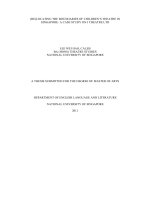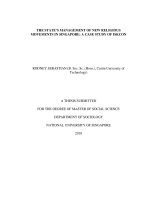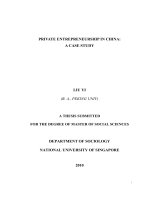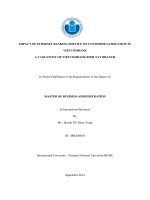After sales service in marketing channel: Case study Honda Vietnam company
Bạn đang xem bản rút gọn của tài liệu. Xem và tải ngay bản đầy đủ của tài liệu tại đây (889.96 KB, 9 trang )
AFTER SALES SERVICE IN MARKETING CHANNEL:
CASE STUDY HONDA VIETNAM COMPANY
Assoc.Prof.Vu Tri Dzung
CFVG
Tran Viet Ha
NEU
Le Viet Cuong
Honda Vietnam
Abstract
Founded in 1996, Honda Vietnam is a joint venture between Honda Motor (Japan),
Asian Honda Motor (Thailand) Co., Ltd. and Vietnam General Motors Corporation. Main
products of Honda Vietnam include motorcycles and cars. After nearly 20 years in
Vietnam, Honda Vietnam has constantly developed and become one of the leading
companies in motorcycle production and automobile manufacturers in Vietnam.
Besides product quality, good customer service organization and management is
key for business success. However, it lacks a systematic analysis on the automobile
distribution management. This research, therefore, focus on customer service policy of
Honda Vietnam company and suggest recommendation on better customer service
improvement decisions, which will help the company to stabilize and compete in the new
phase of development.
Keywords: Automotive industry, Honda Vietnam, Marketing channel, Service quality
1. Introduction
The automotive market of Vietnam is still estimated undersized with the over 20%
growth pattern and more Vietnamese clients with intention to buy a car. This context
reveals the prospective future for foreign investment and assembling operations to break
through the barriers for Vietnamese market penetration. Today, there are 14 OEM
(Original Equipment Manufacturers) brands with local passenger car production in Viet
Nam, even though only 244,914 units were sold in 2015. Up to now, the market has not
fulfilled car makers‘ expectations and the sales volume of individual brands is fairly
limited by international comparison (Martin SCHRÖDER, 2017).
In 2018, the import tax on cars of less than 16 seats will be 0% for vehicles
imported from the Asian region. Vietnam automobile market has encountered many
difficulties, the competition gets fiercer than ever with more discount and promotion
campaigns by the car manufacturers such as Toyota, Honda, Mazda, and Hyundai. (Honda
Motor Vietnam Co., Ltd, 2016).
In such a competitive context, product quality is not enough. Organization and
management of customer service become critically important. Hence, automotive
companies started to measure the value of their customers in seeking to increase their profit
905
(Hawkes, 2000; Kim et al., 2006; Verhoef and Donkers, 2001). The customer value has
been described as the difference between the benefits acquired from targeted customers for
the sake of the enterprise and the burden costs in attracting and serving customers
(Juehling et al., 2010; Kotler, 2000). As a result, establishing continuous and developing
connections with customers will be positively cultivated in the return of investment,
customer retention and even enhancing the brand image. In this regard, accomplishing high
customer satisfaction level requires producing high quality of products (Hendricks and
Singhal, 1997). Therefore, the research on customer service policy of Honda Vietnam
Company to make better decisions on customer service improvement is essential for the
company to stabilize and compete in the new phase of development.
2. Research method
This article uses documents as a qualitative data source in research and discusses
document analysis procedure in the context of actual research experiences. The application of
document analysis to a grounded theory study is illustrated. We use secondary data: Statistics,
reports from various sources: General Statistics Office of Vietnam, data from departments of
Honda Vietnam Company, data from Minister of Trade and Industry and VAMA…
This article also uses the case study method. It is an empirical inquiry that
investigates a phenomenon within its real-life context. The Honda Philosophy consists of
Fundamental Beliefs (including "Respect for the Individual" and "The Three Joys"), the
Company Principle, and Management Policies. Driven by its dreams and reflecting its
values, Honda will continue take on challenges to share joys and excitement with
customers and communities around the world to strive to become a company serving well
the society. To enhance customer satisfaction, Honda Vietnam conducts customer
satisfaction surveys in some product segments in Vietnam such as: motorcycles and
automobiles. Results from the surveys are fed back to the departments involved to work
out practical suggestions for improving daily performance.
3. Result
Overview of business situation of Honda Vietnam Company
After more than one year since the license was granted, Honda Vietnam has
successfully built a factory, dealer network, training programs for sales, service and driver
safety for dealers' agents.
12,000
10,000
8,000
6,000
4,000
2,000
21,173
2,555
22,977
1,804
27,570
4,593
34,257
6,687
42,569
8,312
53,973
50,000
11,404
30,000
10,000
0
-10,000
2011
2012
2013
2014
2015
2016
Figure 1: Total number of Honda cars sold in Vietnam
(Source: Honda Motor Vietnam Co., Ltd, 2012-2016)
906
70,000
Incoming service at distribution channel in 2015 &2016
In 2015 we reached 126,860 customers using maintenance services, which exceeded
the target of 117%. In 2016, we reached 202,966 customers using maintenance services,
with an exceed of 111%. This is result from the effort of the whole nationwide network
(Honda Motor Vietnam Co., Ltd , 2016).
Figure 2: Honda Service incoming
(Source: Honda Motor Vietnam Co., Ltd, 2015-2016)
To achieve our strategic goals in 2015 and 2016, we had paralleled our
factory operations and promoted the agency's operations. For Honda Vietnam, we had
reinforced DLRs‘ activity every month, improved PM mobile activities, provided customer
training on the importance of PM, took service campaigns. For dealers, they had reinforced
some activities like conducting PM mobile and internal service campaigns, programming
for appointment customers, improving DLR image for better comfort of customers,
enhancing daily operation management.
Customer satisfaction index 2015 & 2016
Honda Vietnam always care about the customer satisfaction index (CSI). We will
explain about the customer satisfaction index in 2015 and 2016 to show the efforts of
Honda Vietnam and dealers in the system.
907
Figure 3: Honda – Customer Satisfaction Index, 2015-2016
(Source: Honda Motor Vietnam Co., Ltd, 2015-2016)
The chart of survey result shows that customer satisfaction index when approaching
Honda Dealer tend to increase from the second quarter of 2015 and exceeded Honda's
target. but it had big gap between best Dealer with worst Dealer. In 2016, Honda
recognized the need to improve its dealerships to reduce the gap between Dealers and
increase customer satisfaction Thanks to these actions, the result in 2016 had changed
significantly and exceeded the expectation.
Figure 5: After sale operation: Letter survey Result - Customer satisfaction index
(CSI) 2015 & 2016
908
Honda had set specific measuring criteria of customer satisfaction such as: reminder,
reception, customer lounge, delivery and quality with a target of 870 points. After the
analysis, the criteria in 2016 increases compared with 2015. In addition, some criteria had
been increased, but not significantly higher than other criteria. By evaluating these weak
points, we analyzed the weakness to figure out proper solutions to treat them. For example,
with the weakness of customer lounge, we found that the skill of lounge staff was weak, and
we had taken some activities like hospitality training and internal training for new staffs.
After we took the action, we always check the result and take the picture if necessary.
Evaluation of Honda service quality in benchmarking with competitors
First, we took the primary market analysis between Honda and its competitor. The
research time was in 2015 and 2016. The content of research was Honda CSI overall, DLR
comparison and weak area. We used the method of face to face interview with the
customers. We interviewed 690 customers in 2015 (Honda: 390; Toyota: 180; Mazda:
120) and 750 customers in 2016 (Honda: 450; Toyota: 150; Mazda: 150). We also used our
CSI survey process and category ratio like.
Figure 7: Honda service quality vs competitors
(Source: Honda Motor Vietnam Co., Ltd, 2015-2016)
With the weakness of DLRs like accessibility, waiting time, payment, quality. We
already asked DLRs to make countermeasure and follow up monthly with check sheet to
make sure improvement. We also produced the letter survey every 2 months. In 2016 we
did some on job training for staffs during visiting DLRs and continued some actions for
weak points in 2015.
909
Evaluation of Honda service cost with competitors
In addition to evaluating service standards, Honda also analyzed the service prices
with competitor. First, let‘s review about the labor cost between Honda and Toyota from
2014 to 2016. In 2014 the labor cost in Honda was 180.000VND and Toyota was
230.000VND. In 2015 the labor cost in Honda was 200.000VND and Toyota was
230.000VND. In 2015 the labor cost in Honda was 230.000VND and Toyota was
250.000VND. This means that the average labor cost of Honda is always less than the
labor cost of Toyota. It was equal to 25% in 2016. This made the customer satisfy, because
they got the good service with lower price.
For periodic maintenance (PM) price (PM Part & labor) between Honda versus
Toyota, the PM cost of Honda standard is less than Toyota competitor by 12%. So, we can
say that Honda service price is more attractive than Toyota.
Customers' rating of service networks over competitors
We survey the number of dealers of the main competitors. Toyota's service network
has 46 dealers nationwide, Mazda's service network has 39 dealers, meanwhile Honda has
only 19 dealers nationwide. That means Toyota has more advantages about the network
compared with other Japan companies and Honda is the weakest.
With that challenge, Honda will open more dealers to deal with competitors. In 2017
we have 19 dealers nationwide. We will increase the dealer in the coming years: 28 dealers in
2018, 38 dealers in 2019 and 46 dealers in 2020 to compete with other companies.
Evaluation of customers' expectation and Honda's level of meeting
For the standard service procedure, it includes 8 steps: reminder, appointment,
reception, estimation, while waiting, final check, delivery and follow up. There were 8/8
items that customers satisfy with Honda and there were 3/8 items that customers do not
satisfy with Toyota. That means Honda operation is better than Toyota. However, CSI of
Honda was a little bit lower than Toyota due to:
Dealer network of Toyota is larger than Honda‘s (Toyota 46 DLRs, Honda 19 DLRs).
Repair quality of Toyota is little bit better than Honda‘s. Therefore, Honda will
consider on following items to beat competitors
Opening more dealers in provinces to widen dealer network.
Recruiting manpower of HVN instructor to enhance advance training activity
In service for customer, we take 3 categories such as facility, customer care and
utility to compare with Toyota. With each category, we give out the max items and count
the percentage. Honda in facility gets 100% but Toyota only get 73%. Customer care:
Honda: 83 %; Toyota: 50%; Utility: Honda: 90%; Toyota: 60%. So, we can see that Honda
take care of customer better than Toyota.
910
4. Discussion and Conclusion
In conclusion, although with the efforts in improving the network, quality of service
as well as development of agent system, Honda has achieved encouraging results, it
remains 3 main issues that need to improve. Weak point remained in almost service
process, profit in network was negative and network for service was very small comparing
with competitors.
When finding the issues, we took the discussion to find out the root causes for these
issues and countermeasure for these.
First, weak point remained in almost service process. We defined that there were 6
main root causes. We did not have standard for field staffs following up the service
network. KPI management did not have standard and the dealers controlled themselves.
Repair quality was low comparing with competitors. It did not have clear check sheet
before delivering. The process service did not control as standard. Honda factory had weak
support for network. For these root cause, we discussed to find out the suitable
countermeasures to enhance service process control.
Second, profit in the network was negative. We found the root cause as follow: we
lack knowledge for the network staffs and it did not adjust the price yearly. And the
solution is to improve after sale profit, to train for the network staff knowledge of business,
to consider about adjusting the price yearly.
Third, network for service was very small comparing with competitors. Reviewing
process for qualify the candidate for building the service network and reviewing the
standard to set up service network were the main root causes for the issue. Our action plan
for this is to prepare for open network, to assure the repair quality by focusing on final
check before delivery, to make standard for building new service network.
From above detailed analysis, the main weaknesses are service process, after sale
profit and low network in comparison with competitors. Based on those, there are
propositions to deal with these issues for improved service activities, which will increase
the operation profit and cope with on the Vietnamese Market during 2017-2020. (The
summary of weaknesses and solutions are presented in the table.
To facilitate a process-oriented perspective, waste-free After Sales Service should
already be considered in the After-Sales Service planning. In the field of service planning,
the development and documentation of service processes (process visualization and
definition, reporting guidelines, process descriptions and repair instructions or process
managers), technical instructions and drawings, development of country-specific
guidelines, provisioning of spare parts or spare parts pricing are carried out, to provide
After Sales Service employees with necessary tools and instructions for solving customer
problems.
To get the CSI No 1, 3 countermeasures should be taken strictly. Each solution has
important criteria. We must work hard and stick to it with periodic inspections to find out
the root causes and provide timely solutions.
911
Figure 8: Summary main weak point and proposal
First solution: Enhance control of service process
Company should enhance the service process control. PDCA process application in
service controlling the KPI system help to evaluate the effect of the process.
How to supply high service quality for customer is a big question for any
automobile firms. The first thing we do is to enhance the service process. We follow the 8step process as a standard criterion such as: 1. service reminder 2. service
appointment 3. car reception 4. repair order 5. job control 6. final inspection
7. delivery 8. follow up. On the other hand, we set up the monthly KPI and follow that.
We come to check and discuss the target with dealers every month.
Moreover, we assure the repair quality by using the final check sheet which will be printed
and handed over to the staffs for controlling purpose. After repairing, they must check all the
repair parts and sign on the check sheet, which make sure that we can control the repair quality.
Second solution: Improve after sale profit
First, we find out 3 elements that increase service revenue. Increasing the number of
visit per customer, increasing the revenue per visit, increasing the number of customer are
3 elements to increase after sales profit. When we have more profit, we can give better
service for customers. Second, we use PDCA and monthly KPI to control the target of each
dealer, each item in the service process. Third, the staffs are trained when they are
recruited but they still need to focus on the advance training. The training will help the
dealer to improve their quality of service. Fourth, review the price with competitor and
then consideration for yearly price adjustment.
Third solution: Distribution channel strategy and open network preparation
Cost and customer-service improvements are necessary but not sufficient to transform
auto retailing channels. The full potential of these programs cannot be realized without a
912
reasonable view of the different customer segments that should be targeted; the appropriate mix
and level of marketing and distribution functions needed for each segment, and the best portfolio
of distribution formats and channels to reach the targets (Evan Hirsh & al. 1999).
As discussed above, Honda Vietnam currently have less dealer system than its
competitors. This reduces the majority of CSI and increases the risk of losing customers to
use the service at the dealers. We have the plan to open network to provinces to satisfy the
far customers. We have intension to increase the dealers to 46 dealers nationwide in 2020.
There are several approaches for the use of Lean Production Systems (LPS) in After
Sales Service (Integration of LPS principles into the service planning). LPS allow
companies to focus on activities that enhance the value of the product for the customer, by
creating value and avoiding waste in the processes. Through a successful, sustainable
implementation of a Lean Production Systems in a company, they can act more
responsibly, faster, closer to the customer and transparently in the market. At the same
time, productivity, quality and flexibility can be increased and customer-specific services
can be manufactured under high-quality standards. But most of these approaches are
limited to the single implementation of isolated principles, methods and tools (Uwe
Dombrowskia , Constantin Malorny, 2017).
References
1. Hawkes, V. A. 2000. The heart of the matter: The challenge of customer lifetime
value. CRM Forum Resources
2. Hendricks, K. B. & Singhal, V. R. 1997. Does implementing an effective TQM
program actually improve operating performance? Empirical evidence from firms that have
won quality awards. Management Science 43(9): 1258-1274.
3. Honda Motor Vietnam Co., Ltd , Dealer Business Management Report, Customer
Satisfaction Report, Sales Satisfaction Report, 2015-2016.
4. Juehling, E., Torney, M., Herrmann, C. & Droeder, K. 2010. Integration of
automotive service and technology strategies. CIRP Journal of Manufacturing Science and
Technology 3(2): 98-106
5. Kim, S. Y., Jung, T. S., Suh, E. H. & Hwang, H. S. 2006. Customer segmentation
and strategy development based on customer lifetime value: A case study. Expert Systems
with Applications 31(1): 101-107.
6. Kotler, P. 2000. Marketing management. Upper Saddle River, New Jersey 07458,
USA: Prentice-Hall, Inc.
7. Martin SCHRÖDER (2017), Viet Nam‘s Automotive Supplier Industry:
Development Prospects under Conditions of Free Trade and Global Production Networks
8. Uwe Dombrowskia , Constantin Malorny (2017), Service planning as support
process for a Lean After Sales Service, The 9th CIRP IPSS Conference: Circular
Perspectives on Product/Service-Systems, www.sciencedirect.com
9. Verhoef, P. C. & Donkers, B. 2001. Predicting customer potential value an
application in the insurance industry. Decision Support Systems 32(2): 189-199.
913









